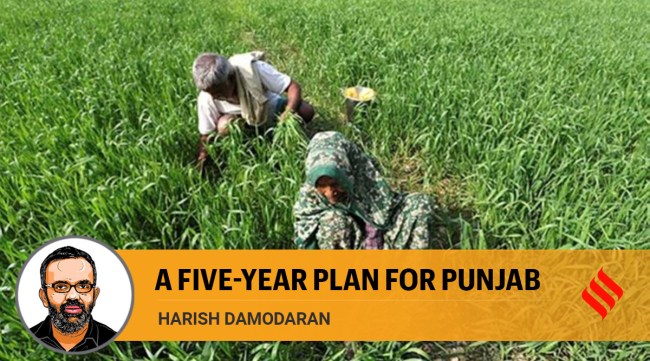Opinion How AAP can fix Punjab’s farms
Harish Damodaran writes: The approach must be practical, not sanctimonious, and take its farmers along rather than viewing them as ‘perpetrators’.
 A legally guaranteed MSP can be made conditional upon farmers cultivating crops suited to agro-ecology and market demand-supply conditions. (File)
A legally guaranteed MSP can be made conditional upon farmers cultivating crops suited to agro-ecology and market demand-supply conditions. (File) Arvind Kejriwal’s Aam Aadmi Party (AAP) is in power in Delhi and now Punjab. It has raised expectations of a solution to the vexed problem of crop stubble burning, particularly during mid-October to around November 10, after paddy is harvested and before sowing of wheat. With both the “perpetrator” and “victim” states being ruled by the same party, despair has given way to hope.
That hope isn’t without basis. AAP is seen as a party with a clean slate, unencumbered by past baggage or links with entrenched interests. And by winning a record 92 out of 117 seats in the recent Assembly elections, it can claim the mandate to do what’s right for Punjab’s agriculture.
So, what should the new government of Bhagwant Singh Mann do? Punjab’s agriculture problem is simple: More than 85 per cent of the gross cropped area in the state is under paddy and wheat, which were, in 2020-21, planted on 31.5 lakh hectares (lh) and 35.1 lh respectively. The 31.5 lh paddy area included 4.1 lh under basmati and 27.4 lh under non-basmati varieties.
Punjab needs a plan of reducing the total paddy area to 15 lh (within that, 5-6 lh under basmati and 9-10 lh under non-basmati) and wheat to 30 lh, over a five-year-period. In paddy, the focus must be to not only halve acreage, but also promote direct seeding, as opposed to conventional transplanting, to the maximum extent. Direct seeded rice requires no nursery preparation, puddling, transplantation and flooding of fields, resulting in about 30 per cent water savings. Farmers further save on transplantation labour costs and nursery-raising time. Thankfully, there are herbicide-tolerant, non-genetically modified paddy varieties today amenable to direct sowing, just like wheat (https://bit.ly/3iwPNK0).
What are the crops that can replace paddy (on 16.5 lh) and wheat (on 5 lh) in Punjab? The alternatives to paddy are cotton, maize, arhar (pigeon pea), soyabean and other kharif pulses and oilseeds. For wheat, it is mainly mustard and chana (chickpea).
A few points are worth noting here.
First, cotton was being grown on over 7 lh area in Punjab till 1990-91. That’s down to 2.5-2.7 lh now. With some effort, an additional 5 lh can be brought under the fibre crop, especially in the southwest Malwa districts of Fazilka, Muktsar, Faridkot, Moga, Bathinda, Mansa, Barnala and Sangrur.
Second, the Punjab farmer will switch only to crops that are reasonably high-yielding and fetch much better prices than paddy and wheat. Yields per hectare in the state average around 70 quintals for non-basmati paddy and 50 quintals for wheat. The minimum support price (MSP) of paddy is Rs 1,960/quintal and Rs 2,015//quintal for wheat, with their corresponding per-hectare cultivation costs at roughly Rs 62,500 and Rs 37,500 respectively. The returns, thus, range from Rs 63,000 to Rs 75,000 per hectare.
That being so, any alternative crop has to give at least comparative returns for making it worthwhile to plant. The Indian Agricultural Research Institute, which bred the earlier-mentioned herbicide-tolerant direct seeded rice, has developed Pusa Arhar-16 and Pusa Parvati. The first one is an arhar and the second a chana variety, yielding an average 20 quintals and 25 quintals of grain per hectare respectively. At their MSPs of Rs 6,300/quintal and Rs 5,230/quintal — cultivation costs are only Rs 25,000/hectare each — the returns work out in excess of Rs 1,00,000 per hectare.
Third, the above calculations make sense only if the government undertakes procurement at the declared MSPs — like it does for paddy and wheat. The Punjab farmer will definitely grow pulses if she is assured of MSP, which should ideally factor in the environmental gains from atmospheric nitrogen fixation and lower water consumption. The same goes for oilseeds, where yields are, however, a constraint. These average less than 15 quintals per hectare for mustard in Punjab, while existing soyabean varieties give 20 quintals at best. Both the AAP government and the Centre have to be open to genetic modification technology: Roundup Ready herbicide-tolerant soyabean and the Delhi University’s indigenously-developed Barnase-Barstar gene-based mustard hybrids can raise yields to 25-30 quintals per hectare. The Punjab farmer, to repeat, will not touch any crop yielding below global average.
Fourth, the Punjab farmer wants to grow high-yielding crops that can also be mechanically harvested. Pusa Arhar-16 matures in 120 days, as against 160-180 days for normal pigeon pea varieties. Moreover, the plants are semi-dwarf, semi-erect and have a compact canopy, with synchronous flowering and pod-setting at the top. Farmers can, hence, easily apply pesticides using regular knapsack sprayers and harvest the crop at one go using combines. In Pusa Parvati chana, too, pod formation is profuse at the top. Since the bottom 20-25 cm portion of the stems bear no pods, the combines can run and harvest the entire yield.
Fifth, the crop diversification plan suggested cannot succeed without central support. The latter should fund MSP procurement of pulses, oilseeds, maize and cotton from Punjab, the way it is already doing for paddy and wheat. Arhar and chana can be sold through the public distribution system.
In cotton, maize and oilseeds, building an eco-system of ginning-and-pressing units, feed mills, corn starch and solvent extraction plants may take time. Some handholding is necessary during this transition. Fortunately, prices of cotton, maize, soyabean and mustard are all ruling high, thanks to the post-Covid and the Ukraine war-induced global supply disruptions. That’s all the more reason to launch the proposed five-year plan of slashing paddy and wheat acreages — which is also the key to solving the stubble burning problem – from the coming kharif cropping season itself.
Last but not least, assured MSP should go hand in hand with crop area planning. Targeted reduction in paddy and wheat area can succeed only if farmers are confident about prices of the desired alternative crops at the time of harvest. A legally guaranteed MSP can be made conditional upon farmers cultivating crops suited to agro-ecology (a function of water availability and soil types) and market demand-supply conditions (https://bit.ly/3wya6yU).
Fixing Punjab’s agriculture calls for an approach that is practical, not sanctimonious, and takes its farmers along rather than viewing them as “perpetrators”. The Punjab farmer has fed India in times of need. We can trust in her more than god to make India atmanirbhar in pulses and edible oil.
This column first appeared in the print edition on March 25, 2022 under the title ‘A five-year plan for Punjab’. The writer is National Rural Affairs and Agriculture Editor of The Indian Express and Senior Fellow at the Centre for Policy Research






